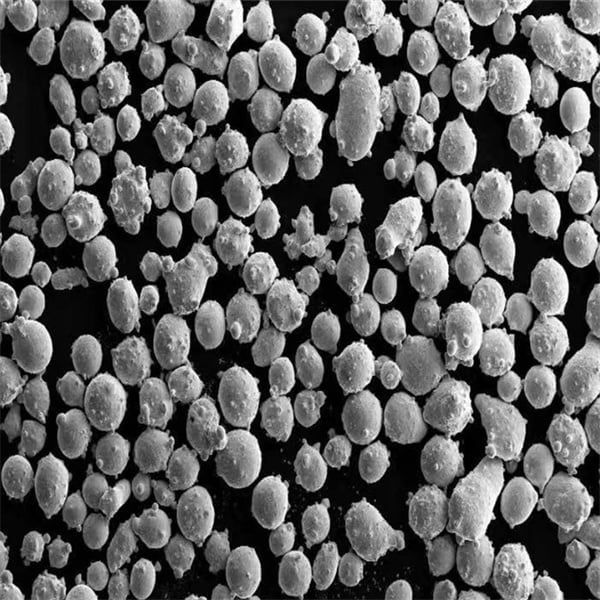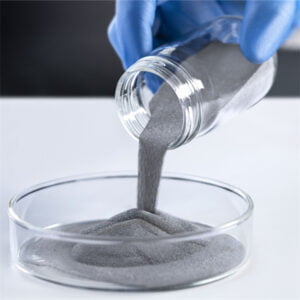Vakuum-Inertgaszerstäubung
Inhaltsübersicht
Übersicht
In der Welt der fortschrittlichen Fertigung hat das Streben nach Perfektion bei den Materialien zur Entwicklung zahlreicher hochentwickelter Techniken geführt. Eine dieser revolutionären Methoden ist Vakuum-Inertgaszerstäubung (VIGA). Dieses Verfahren spielt eine entscheidende Rolle bei der Herstellung hochwertiger Metallpulver, die für verschiedene Anwendungen wie additive Fertigung, Pulvermetallurgie und Spezialbeschichtungen unerlässlich sind. In diesem Artikel befassen wir uns mit den Feinheiten des VIGA-Verfahrens und untersuchen seine Prozesse, Vorteile, Grenzen und Anwendungen.
Überblick über die Vakuum-Inertgaszerstäubung
Die Vakuum-Inertgaszerstäubung (VIGA) ist ein modernes Verfahren zur Herstellung feiner, kugelförmiger Metallpulver. Bei diesem Verfahren wird ein Metall unter Vakuum geschmolzen und dann ein Inertgas eingeleitet, um das geschmolzene Metall in winzige Tröpfchen zu zerstäuben, die zu feinen Pulvern erstarren. VIGA ist bekannt für seine Fähigkeit, hochreine Pulver mit kontrollierter Partikelgröße herzustellen, was es in der Hochpräzisionsindustrie unverzichtbar macht.

Wie Vakuum-Inertgaszerstäubung Funktioniert
VIGA arbeitet in einer kontrollierten Umgebung, um die Herstellung von Metallpulvern höchster Qualität zu gewährleisten. Hier finden Sie eine schrittweise Aufschlüsselung des Prozesses:
- Schmelzen: Das Metall oder die Legierung wird in einem Vakuum-Induktionsofen geschmolzen.
- Zerstäubung: Das geschmolzene Metall wird durch eine Düse in eine Kammer gegossen, wo es durch einen Hochdruckstrom aus Inertgas (wie Argon oder Stickstoff) zerstäubt wird.
- Erstarrung: Die winzigen Metalltröpfchen kühlen schnell ab und verfestigen sich zu feinen, kugelförmigen Pulvern.
- Sammlung: Die Pulver werden in einer Kammer gesammelt, vom Inertgas getrennt und gesiebt, um die gewünschte Partikelgrößenverteilung zu erreichen.
Die wichtigsten von VIGA hergestellten Metallpulvermodelle
Mit dem VIGA-Verfahren kann eine breite Palette von Metallpulvern hergestellt werden, von denen jedes über einzigartige Eigenschaften verfügt, die auf bestimmte Anwendungen zugeschnitten sind. Hier sind einige bemerkenswerte Modelle:
| Metallpulver-Modell | Zusammensetzung | Eigenschaften | Anwendungen |
|---|---|---|---|
| 316L-Edelstahl | Fe-16.5Cr-10Ni-2Mo | Hohe Korrosionsbeständigkeit, gute Schweißbarkeit | Medizinische Implantate, Komponenten für die Luft- und Raumfahrt |
| Ti-6Al-4V | Ti-6Al-4V | Hohes Festigkeits-Gewichts-Verhältnis, biokompatibel | Teile für die Luft- und Raumfahrt, biomedizinische Geräte |
| AlSi10Mg | Al-10Si-0,4Mg | Leichtes Gewicht, gute Wärmeleitfähigkeit | Automobilteile, Wärmetauscher |
| Inconel 718 | Ni-52Cr-19Fe-5Nb-3Mo-1Ti | Hohe Temperaturbeständigkeit, Korrosionsbeständigkeit | Turbinenschaufeln, Kernreaktoren |
| Kupfer | Reines Cu | Hervorragende elektrische und thermische Leitfähigkeit | Elektrische Komponenten, Wärmesenken |
| Martensitaushärtender Stahl (18Ni300) | Fe-18Ni-9Co-5Mo-1.5Ti | Hohe Festigkeit, gute Zähigkeit | Werkzeugbau, Hochleistungsteile |
| Kobalt-Chrom (CoCrMo) | Co-28Cr-6Mo | Hohe Verschleißfestigkeit, biokompatibel | Zahnimplantate, orthopädische Geräte |
| Superlegierungen auf Nickelbasis (Hastelloy X) | Ni-22Cr-18Fe-9Mo | Außergewöhnliche Oxidations- und Korrosionsbeständigkeit | Luft- und Raumfahrt, chemische Verarbeitung |
| Aluminium-Legierung 7075 | Al-5,6Zn-2,5Mg-1,6Cu | Hohe Festigkeit, gute Ermüdungsbeständigkeit | Rahmen für die Luft- und Raumfahrt, Sportartikel |
| Stellit 21 | Co-28Cr-4Mo | Abriebfestigkeit, hohe Temperaturbeständigkeit | Schneidwerkzeuge, Motorkomponenten |
Anwendungen der Vakuum-Inertgaszerstäubung
Die Vielseitigkeit der von VIGA hergestellten Pulver eröffnet zahlreiche Anwendungen in verschiedenen Branchen. Hier sind einige der wichtigsten Anwendungen:
| Industrie | Anwendungen |
|---|---|
| Luft- und Raumfahrt | Turbinenschaufeln, Strukturkomponenten, Befestigungselemente |
| Medizinische | Orthopädische Implantate, Zahnprothetik |
| Automobilindustrie | Motorenteile, leichte Strukturbauteile |
| Elektronik | Leitfähige Tinten, Lötmaterialien |
| Energie | Kernreaktoren, Brennstoffzellen |
| Werkzeugbau | Schneidwerkzeuge, Formen, Matrizen |
| Additive Fertigung | 3D-Druck, Prototyping |
| Beschichtungen | Wärmedämmschichten, verschleißfeste Beschichtungen |
Vorteile von Vakuum-Inertgaszerstäubung
VIGA bietet mehrere Vorteile, die es zu einer bevorzugten Wahl für die Metallpulverproduktion machen:
- Hohe Reinheit: Die Vakuumumgebung minimiert die Kontamination und sorgt für hochreine Pulver.
- Kontrollierte Partikelgröße: Die präzise Steuerung der Zerstäubungsparameter führt zu einer einheitlichen Partikelgröße.
- Sphärische Partikel: Das Verfahren erzeugt kugelförmige Pulver, die die Fließfähigkeit und Packungsdichte verbessern.
- Vielseitigkeit: Verarbeitung einer breiten Palette von Metallen und Legierungen.
- Reduzierte Oxidation: Die Inertgasumgebung reduziert die Oxidation und bewahrt die Eigenschaften des Pulvers.
Nachteile der Vakuum-Inertgaszerstäubung
Trotz seiner vielen Vorteile hat VIGA einige Einschränkungen:
- Hohe Kosten: Die Kosten für Ausrüstung und Betrieb sind im Vergleich zu anderen Zerstäubungsmethoden relativ hoch.
- Komplexität: Das Verfahren erfordert ausgeklügelte Kontrollsysteme und geschultes Personal.
- Begrenzter Produktionsumfang: Normalerweise ist VIGA eher für kleine bis mittlere Produktionsmengen geeignet.
Vergleich von VIGA mit anderen Zerstäubungsmethoden
Bei der Wahl einer Zerstäubungsmethode ist es wichtig, VIGA mit anderen Techniken wie Wasserzerstäubung und Gaszerstäubung zu vergleichen. Hier sehen Sie, wie sie im Vergleich stehen:
| Methode | Partikelform | Reinheit | Kosten | Produktionsmaßstab | Anwendungen |
|---|---|---|---|---|---|
| VIGA | Sphärisch | Hoch | Hoch | Mittel | Hochpräzisionsindustrie, Luft- und Raumfahrt |
| Wasserzerstäubung | Unregelmäßig | Mäßig | Niedrig | Hoch | Pulvermetallurgie, Stahlpulver |
| Gaszerstäubung | Sphärisch | Hoch | Mäßig | Mittel | Additive Fertigung, Speziallegierungen |

Spezifikationen, Größen und Normen
Um Konsistenz und Qualität zu gewährleisten, werden die von VIGA hergestellten Metallpulver nach bestimmten Normen und Spezifikationen hergestellt:
| Metallpulver | Partikelgrößenbereich (µm) | Normen |
|---|---|---|
| 316L-Edelstahl | 15-45, 45-150 | ASTM A276, ISO 5832-1 |
| Ti-6Al-4V | 15-53, 53-150 | ASTM F2924, ISO 5832-3 |
| AlSi10Mg | 20-63, 63-125 | ASTM B928, ISO 209-1 |
| Inconel 718 | 15-45, 45-150 | ASTM B637, ISO 6208 |
| Kupfer | 10-75, 75-150 | ASTM B216, ISO 3497 |
| Martensitaushärtender Stahl (18Ni300) | 15-45, 45-150 | ASTM A646, ISO 4955 |
| Kobalt-Chrom (CoCrMo) | 20-53, 53-150 | ASTM F1537, ISO 5832-4 |
| Superlegierungen auf Nickelbasis (Hastelloy X) | 15-53, 53-150 | ASTM B435, ISO 6208 |
| Aluminium-Legierung 7075 | 20-63, 63-125 | ASTM B209, ISO 6362-2 |
| Stellit 21 | 20-63, 63-150 | ASTM F75, ISO 5832-4 |
Lieferanten und Preisangaben
Die Suche nach zuverlässigen Lieferanten und die Kenntnis der Preisgestaltung sind für die Beschaffung unerlässlich. Hier ist eine Momentaufnahme einiger bekannter Lieferanten und ihrer Preise:
| Anbieter | Angebotene Metallpulver | Preisspanne (pro kg) | Standort |
|---|---|---|---|
| Sandvik Fischadler | Rostfreier Stahl, Titan | $150 – $300 | Schweden |
| Tischlertechnik | Nickellegierungen, Kobaltlegierungen | $200 – $500 | USA |
| Höganäs AB | Stahlpulver, Aluminium | $50 – $200 | Schweden |
| LPW-Technologie | Verschiedene Legierungen, kundenspezifische Pulver | $100 – $400 | UK |
| AP&C (GE-Zusatzstoff) | Titan, Aluminium | $200 – $600 | Kanada |
Pro und Kontra Vergleich
Um fundierte Entscheidungen treffen zu können, ist es wichtig, die Vorteile und Grenzen von VIGA zu kennen:
| Profis | Nachteile |
|---|---|
| Hohe Reinheit und kontrollierte Zusammensetzung | Hohe Kosten für Ausrüstung und Betrieb |
| Sphärische Partikel mit guter Fließfähigkeit | Erfordert qualifiziertes Personal |
| Vielseitigkeit bei Metallen und Legierungen | Begrenzt auf kleine bis mittlere Produktionsmengen |
| Reduzierte Oxidation durch Inertgas | Komplexer Prozess mit strenger Kontrolle |

FAQ
| Frage | Antwort |
|---|---|
| Wofür wird VIGA verwendet? | VIGA wird zur Herstellung von hochwertigen Metallpulvern für Anwendungen in der Luft- und Raumfahrt, der Medizin und der additiven Fertigung eingesetzt. |
| Wie unterscheidet sich VIGA von der Gaszerstäubung? | VIGA verwendet ein Vakuum und Inertgas, um Verunreinigungen und Oxidation zu minimieren, was zu Pulvern von höherer Reinheit führt. |
| Welche Metalle können mit VIGA verarbeitet werden? | Eine breite Palette von Metallen und Legierungen, darunter Edelstahl, Titan, Aluminium und Superlegierungen auf Nickelbasis. |
| Welche Partikelgrößenbereiche können mit VIGA erreicht werden? | In der Regel kann VIGA Pulver mit Partikelgrößen von 10 µm bis 150 µm herstellen. |
| Ist VIGA kosteneffizient? | VIGA bietet zwar hohe Qualität und Präzision, ist aber im Allgemeinen teurer als andere Zerstäubungsmethoden. |
Zusammenfassend lässt sich sagen, dass die Vakuum-Inertgaszerstäubung ein erstklassiges Verfahren zur Herstellung von hochwertigen Metallpulvern ist, die für verschiedene Hochpräzisionsanwendungen unerlässlich sind. Ihre Fähigkeit, kugelförmige, hochreine Pulver mit kontrollierter Partikelgröße herzustellen, macht sie in Bereichen von der Luft- und Raumfahrt bis zu medizinischen Implantaten unverzichtbar. Obwohl es mit höheren Kosten und höherer Komplexität verbunden ist, überwiegen die Vorteile oft die Nachteile bei Anwendungen, die eine erstklassige Materialleistung erfordern. Angesichts der fortschreitenden Innovationen in der Industrie kann die Rolle fortschrittlicher Techniken wie VIGA bei der Gestaltung der Zukunft der Fertigung nicht hoch genug eingeschätzt werden.
Teilen auf
MET3DP Technology Co., LTD ist ein führender Anbieter von additiven Fertigungslösungen mit Hauptsitz in Qingdao, China. Unser Unternehmen ist spezialisiert auf 3D-Druckgeräte und Hochleistungsmetallpulver für industrielle Anwendungen.
Fragen Sie an, um den besten Preis und eine maßgeschneiderte Lösung für Ihr Unternehmen zu erhalten!
Verwandte Artikel

Hochleistungs-Düsenschaufelsegmente: Revolutionierung der Turbineneffizienz mit 3D-Metalldruck
Mehr lesen "Über Met3DP
Aktuelles Update
Unser Produkt
KONTAKT US
Haben Sie Fragen? Senden Sie uns jetzt eine Nachricht! Wir werden Ihre Anfrage mit einem ganzen Team nach Erhalt Ihrer Nachricht bearbeiten.
Holen Sie sich Metal3DP's
Produkt-Broschüre
Erhalten Sie die neuesten Produkte und Preislisten

Metallpulver für 3D-Druck und additive Fertigung
UNTERNEHMEN
PRODUKT
cONTACT INFO
- Qingdao Stadt, Shandong, China
- [email protected]
- [email protected]
- +86 19116340731
















